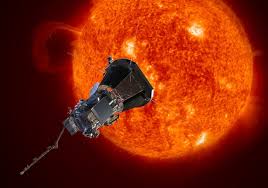NASA to launch Parker Solar Probe to explore sun’s outer atmosphere
NASA is going to launch Parker Solar Probe in 2018 to explore the sun’s outer atmosphere. It will be launched onboard of Delta IV Heavy launch vehicle. It will perform its scientific investigations in a hazardous region of intense heat and solar radiation.
Primary goals of mission: Trace how energy and heat move through solar corona. Explore what accelerates solar wind as well as solar energetic particles.
Parker Solar Probe mission
It is NASA’s planned robotic spacecraft to probe outer corona of Sun. It has been designed and built by Johns Hopkins University Applied Physics Laboratory. It is named after solar astrophysicist Eugene Parker. This is first time NASA spacecraft named after living person.
The spacecraft is designed to endure harsh environment near Sun, by approaching within 8.5 solar radii (5.9 million kilometers) to ‘surface’ (photosphere) of Sun where incident solar intensity is approximately 520 times intensity at Earth orbit. It will be protected by solar shadow-shield made of reinforced carbon-carbon composite.
The spacecraft systems and scientific instruments are located in central portion of shield’s shadow, where direct radiation from Sun is fully blocked. The primary power for mission is dual system of solar panels (photovoltaic array). Secondary source consists of much smaller secondary array power that uses pumped-fluid cooling to maintain operating temperature. It will use Venus’ gravity during seven flybys over nearly seven years to gradually bring its orbit closer to Sun. It will achieve velocity of up to 200 km/s, making it fastest spacecraft to date.
Scientific goals
- Determine structure and dynamics of magnetic fields at sources of solar wind.
- Trace flow of energy that heats corona and accelerates solar wind.
- Determine what mechanisms accelerate and transport energetic particles.
- Explore dusty plasma near Sun and its influence on solar wind and energetic particle formation.

Month: Current Affairs - January, 2018


